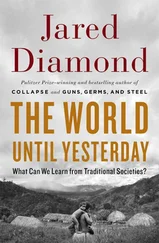Jared Diamond - Guns, Germs & Steel
Здесь есть возможность читать онлайн «Jared Diamond - Guns, Germs & Steel» весь текст электронной книги совершенно бесплатно (целиком полную версию без сокращений). В некоторых случаях можно слушать аудио, скачать через торрент в формате fb2 и присутствует краткое содержание. Жанр: 105. Описание произведения, (предисловие) а так же отзывы посетителей доступны на портале библиотеки ЛибКат.
- Название:Guns, Germs & Steel
- Автор:
- Жанр:
- Год:неизвестен
- ISBN:нет данных
- Рейтинг книги:5 / 5. Голосов: 1
-
Избранное:Добавить в избранное
- Отзывы:
-
Ваша оценка:
- 100
- 1
- 2
- 3
- 4
- 5
Guns, Germs & Steel: краткое содержание, описание и аннотация
Предлагаем к чтению аннотацию, описание, краткое содержание или предисловие (зависит от того, что написал сам автор книги «Guns, Germs & Steel»). Если вы не нашли необходимую информацию о книге — напишите в комментариях, мы постараемся отыскать её.
Guns, Germs & Steel — читать онлайн бесплатно полную книгу (весь текст) целиком
Ниже представлен текст книги, разбитый по страницам. Система сохранения места последней прочитанной страницы, позволяет с удобством читать онлайн бесплатно книгу «Guns, Germs & Steel», без необходимости каждый раз заново искать на чём Вы остановились. Поставьте закладку, и сможете в любой момент перейти на страницу, на которой закончили чтение.
Интервал:
Закладка:
HOW AFRICA BECAME BLACK • 385
guages, are packed into a tiny area of Cameroon and adjacent eastern Nigeria.
Evidently, the Niger-Congo language family arose in West Africa; the Bantu branch of it arose at the east end of that range, in Cameroon and Nigeria; and the Bantu then spread out of that homeland over most of subequatorial Africa. That spread must have begun long ago enough that the ancestral Bantu language had time to split into 500 daughter languages, but nevertheless recently enough that all those daughter languages are still very similar to each other. Since all other Niger-Congo speakers, as well as the Bantu, are blacks, we couldn't have inferred who migrated in which direction just from the evidence of physical anthropology.
To make this type of linguistic reasoning clear, let me give you a familiar example: the geographic origins of the English language. Today, by far the largest number of people whose first language is English live in North America, with others scattered over the globe in Britain, Australia, and other countries. Each of those countries has its own dialects of English. If we knew nothing else about language distributions and history, we might have guessed that the English language arose in North America and was carried overseas to Britain and Australia by colonists.
But all those English dialects form only one low-order subgroup of the Germanic language family. All the other subgroups—the various Scandinavian, German, and Dutch languages—are crammed into northwestern Europe. In particular, Frisian, the other Germanic language most closely related to English, is confined to a tiny coastal area of Holland and western Germany. Hence a linguist would immediately deduce correctly that the English language arose in coastal northwestern Europe and spread around the world from there. In fact, we know from recorded history that English really was carried from there to England by invading Anglo-Saxons in the fifth and sixth centuries a.d.
Essentially the same line of reasoning tells us that the nearly 200 million Bantu people, now flung over much of the map of Africa, arose from Cameroon and Nigeria. Along with the North African origins of Semites and the origins of Madagascar's Asians, that's another conclusion that we couldn't have reached without linguistic evidence.
We had already deduced, from Khoisan language distributions and the lack of distinct Pygmy languages, that Pygmies and Khoisan peoples had formerly ranged more widely, until they were engulfed by blacks. (I'm using "engulfing" as a neutral all-embracing word, regardless of whether
386 • GUNS, GERMS, AND STEEL
the process involved conquest, expulsion, interbreeding, killing, or epidemics.) We've now seen, from Niger-Congo language distributions, that the blacks who did the engulfing were the Bantu. The physical and linguistic evidence considered so far has let us infer these prehistoric engulfings, but it still hasn't solved their mysteries for us. Only the further evidence that I'll now present can help us answer two more questions: What advantages enabled the Bantu to displace the Pygmies and Khoisan? When did the Bantu reach the former Pygmy and Khoisan homelands?
To approach the question about the Bantu's advantages, let's examine the remaining type of evidence from the living present—the evidence derived from domesticated plants and animals. As we saw in previous chapters, that evidence is important because food production led to high population densities, germs, technology, political organization, and other ingredients of power. Peoples who, by accident of their geographic location, inherited or developed food production thereby became able to engulf geographically less endowed people.
When Europeans reached sub-Saharan Africa in the 1400s, Africans were growing five sets of crops (Figure 19.3), each of them laden with significance for African history. The first set was grown only in North Africa, extending to the highlands of Ethiopia. North Africa enjoys a Mediterranean climate, characterized by rainfall concentrated in the winter months. (Southern California also experiences a Mediterranean climate, explaining why my basement and that of millions of other southern Cali-fornians often gets flooded in the winter but infallibly dries out in the summer.) The Fertile Crescent, where agriculture arose, enjoys that same Mediterranean pattern of winter rains.
Hence North Africa's original crops all prove to be ones adapted to germinating and growing with winter rains, and known from archaeological evidence to have been first domesticated in the Fertile Crescent beginning around 10,000 years ago. Those Fertile Crescent crops spread into climatically similar adjacent areas of North Africa and laid the foundations for the rise of ancient Egyptian civilization. They include such familiar crops as wheat, barley, peasj beans, and grapes. These are familiar to us precisely because they also spread into climatically similar adjacent areas of Europe, thence to America and Australia, and became some of the staple crops of temperate-zone agriculture around the world.
HOW AFRICA BECAME BLACK • 387
Origins of African crops, with examples
(sorghum, pearl millet) S
Figure 19.3. The areas of origin of crops grown traditionally in Africa (that is, before the arrival of crops carried by colonizing Europeans), with examples of two crops from each area.
As one travels south in Africa across the Saharan desert and reencoun-ters rain in the Sahel zone just south of the desert, one notices that Sahel rains fall in the summer rather than in the winter. Even if Fertile Crescent crops adapted to winter rain could somehow have crossed the Sahara, they would have been difficult to grow in the summer-rain Sahel zone. Instead, we find two sets of African crops whose wild ancestors occur just south of the Sahara, and which are adapted to summer rains and less seasonal vari-
388 • GUNS, GERMS, AND STEEL
ation in day length. One set consists of plants whose ancestors are widely distributed from west to east across the Sahel zone and were probably domesticated there. They include, notably, sorghum and pearl millet, which became the staple cereals of much of sub-Saharan Africa. Sorghum proved so valuable that it is now grown in areas with hot, dry climates on all the continents, including in the United States.
The other set consists of plants whose wild ancestors occur in Ethiopia and were probably domesticated there in the highlands. Most are still grown mainly just in Ethiopia and remain unknown to Americans— including Ethiopia's narcotic chat, its banana-like ensete, its oily noog, its finger millet used to brew its national beer, and its tiny-seeded cereal called teff, used to make its national bread. But every reader addicted to coffee can thank ancient Ethiopian farmers for domesticating the coffee plant. It remained confined to Ethiopia until it caught on in Arabia and then around the world, to sustain today the economies of countries as far-flung as Brazil and Papua New Guinea.
The next-to-last set of African crops arose from wild ancestors in the wet climate of West Africa. Some, including African rice, have remained virtually confined there; others, such as African yams, spread.throughout other areas of sub-Saharan Africa; and two, the oil palm and kola nut, reached other continents. West Africans were chewing the caffeine-containing nuts of the latter as a narcotic, long before the Coca-Cola Company enticed first Americans and then the world to drink a beverage originally laced with its extracts.
The last batch of African crops is also adapted to wet climates but provides the biggest surprise of Figure 19.3. Bananas, Asian yams, and taro were already widespread in sub-Saharan Africa in the 1400s, and Asian rice was established on the coast of East Africa. But those crops originated in tropical Southeast Asia. Their presence in Africa would astonish us, if the presence of Indonesian people on Madagascar had not already alerted us to Africa's prehistoric Asian connection. Did Austronesians sailing from Borneo land on the East African coast, bestow their crops on. grateful African fanners, pick up African fishermen, and sail off into the sunrise to colonize Madagascar, leaving no other Austronesian traces in Africa?
The remaining surprise is that all of Africa's indigenous crops—those of the Sahel, Ethiopia, and West Africa—originated north of the equator. Not a single African crop originated south of it. This already gives us a
Интервал:
Закладка:
Похожие книги на «Guns, Germs & Steel»
Представляем Вашему вниманию похожие книги на «Guns, Germs & Steel» списком для выбора. Мы отобрали схожую по названию и смыслу литературу в надежде предоставить читателям больше вариантов отыскать новые, интересные, ещё непрочитанные произведения.
Обсуждение, отзывы о книге «Guns, Germs & Steel» и просто собственные мнения читателей. Оставьте ваши комментарии, напишите, что Вы думаете о произведении, его смысле или главных героях. Укажите что конкретно понравилось, а что нет, и почему Вы так считаете.










